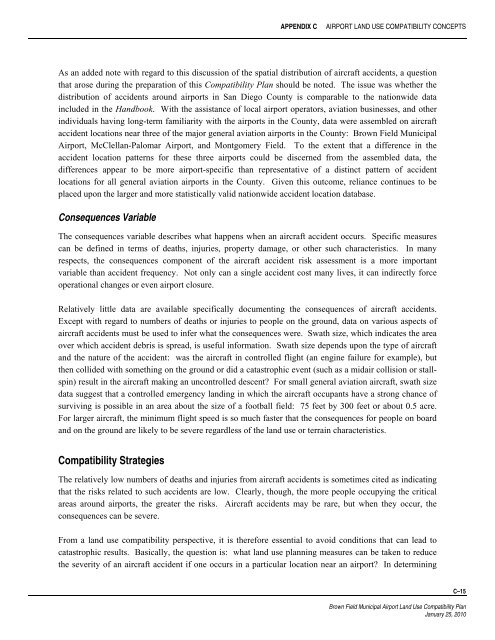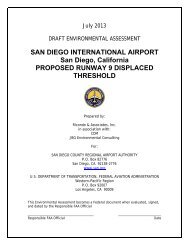Brown Field Municipal Airport Land Use Compatibility Plan
Brown Field Municipal Airport Land Use Compatibility Plan
Brown Field Municipal Airport Land Use Compatibility Plan
- No tags were found...
You also want an ePaper? Increase the reach of your titles
YUMPU automatically turns print PDFs into web optimized ePapers that Google loves.
APPENDIX CAIRPORT LAND USE COMPATIBILITY CONCEPTSAs an added note with regard to this discussion of the spatial distribution of aircraft accidents, a questionthat arose during the preparation of this <strong>Compatibility</strong> <strong>Plan</strong> should be noted. The issue was whether thedistribution of accidents around airports in San Diego County is comparable to the nationwide dataincluded in the Handbook. With the assistance of local airport operators, aviation businesses, and otherindividuals having long-term familiarity with the airports in the County, data were assembled on aircraftaccident locations near three of the major general aviation airports in the County: <strong>Brown</strong> <strong>Field</strong> <strong>Municipal</strong><strong>Airport</strong>, McClellan-Palomar <strong>Airport</strong>, and Montgomery <strong>Field</strong>. To the extent that a difference in theaccident location patterns for these three airports could be discerned from the assembled data, thedifferences appear to be more airport-specific than representative of a distinct pattern of accidentlocations for all general aviation airports in the County. Given this outcome, reliance continues to beplaced upon the larger and more statistically valid nationwide accident location database.Consequences VariableThe consequences variable describes what happens when an aircraft accident occurs. Specific measurescan be defined in terms of deaths, injuries, property damage, or other such characteristics. In manyrespects, the consequences component of the aircraft accident risk assessment is a more importantvariable than accident frequency. Not only can a single accident cost many lives, it can indirectly forceoperational changes or even airport closure.Relatively little data are available specifically documenting the consequences of aircraft accidents.Except with regard to numbers of deaths or injuries to people on the ground, data on various aspects ofaircraft accidents must be used to infer what the consequences were. Swath size, which indicates the areaover which accident debris is spread, is useful information. Swath size depends upon the type of aircraftand the nature of the accident: was the aircraft in controlled flight (an engine failure for example), butthen collided with something on the ground or did a catastrophic event (such as a midair collision or stallspin)result in the aircraft making an uncontrolled descent? For small general aviation aircraft, swath sizedata suggest that a controlled emergency landing in which the aircraft occupants have a strong chance ofsurviving is possible in an area about the size of a football field: 75 feet by 300 feet or about 0.5 acre.For larger aircraft, the minimum flight speed is so much faster that the consequences for people on boardand on the ground are likely to be severe regardless of the land use or terrain characteristics.<strong>Compatibility</strong> StrategiesThe relatively low numbers of deaths and injuries from aircraft accidents is sometimes cited as indicatingthat the risks related to such accidents are low. Clearly, though, the more people occupying the criticalareas around airports, the greater the risks. Aircraft accidents may be rare, but when they occur, theconsequences can be severe.From a land use compatibility perspective, it is therefore essential to avoid conditions that can lead tocatastrophic results. Basically, the question is: what land use planning measures can be taken to reducethe severity of an aircraft accident if one occurs in a particular location near an airport? In determiningC–15<strong>Brown</strong> <strong>Field</strong> <strong>Municipal</strong> <strong>Airport</strong> <strong>Land</strong> <strong>Use</strong> <strong>Compatibility</strong> <strong>Plan</strong>January 25, 2010
















